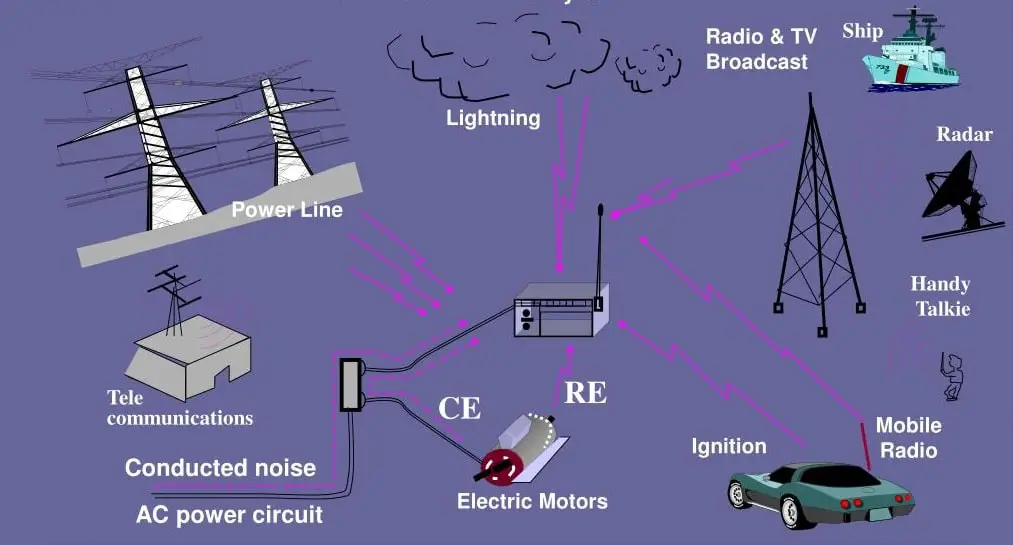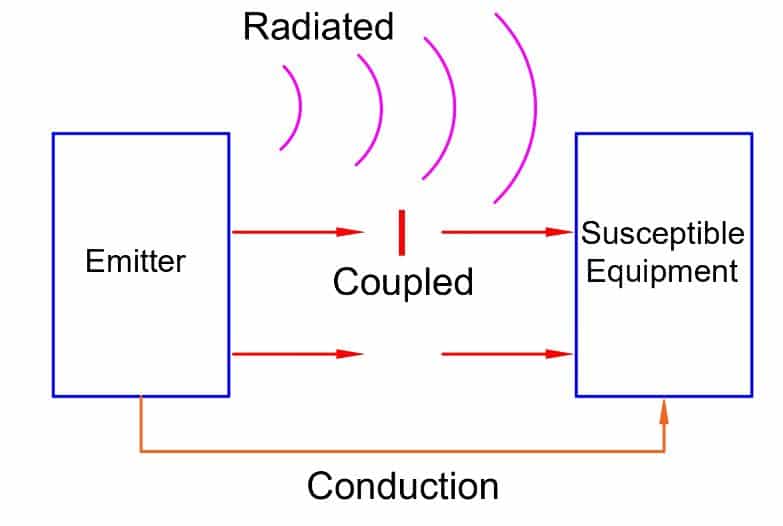EMI, Electromagnetic Interference is the interference caused by electrical and magnetic fields. The electromagnetic field produced by an electronic or electrical device interferes with another device, and thus it causes EMI interference. The EMI interference happens only when both the electrical and magnetic fields exist together.
Electromagnetic Interference– Definition
When two or more signals travel in the parallel, the signals set up the electric and magnetic field, and further, the electric and magnetic field radiates electromagnetic waves. The EM waves of one signal may interfere with other signals & vice versa. This phenomenon is called Electromagnetic Interference(EMI).
Any device that has electronic circuitry is apt to effect by EMI. Therefore, it is a must to protect electronic devices from EMI & RFI interference.

Electromagnetic interference, EMI is an unwanted signal at the signal receiver. And, there is a need to reduce it up to a certain extent. The frequency range of EMI interference is in the range of 2 kHz up to 150 kHz. The EMI interference takes place at a lower frequency and at a higher frequency as well, therefore it is a must to reduce EMI for the entire frequency range.
There are various frequency spectrums in which electrical & electronic devices are generally operating. For example, the electrical power transmission line, nuclear submarines, and brain waves have an extremely low frequency. The FM & AM communication, TV, radar, cell phone & satellite dish use infrared. The ultraviolet and x-rays are alpha rays, beta rays, gamma rays, cosmic rays, and radioactive particles,
EMI Coupling Mechanisms
The electromagnetic interference can couple from the source to the receiver in many ways. By understanding the types of coupling which create EMI, it is easy to analyze the problem to reduce the EMI interference. The electromagnetic interference is very strong, and it can interfere with any frequency including the originating frequency.

We can categorize the different types of EMI in a number of ways. The followings are the categories of EMI by the way they arise.
Radiated
The strangeness of EMI coupling depends on the distance between the transmitter and receiver- typically more than a wavelength. If the distance between the transmitter and receive is more than its wavelength, the electromagnetic interference is more. Therefore, this type of EMI coupling is the most obvious.
Conducted
Conducted emissions happen when electromagnetic waves find their conduction route along with the signals travel. This may be along with power cables or another interconnection cabling. The conduction may be in one of two modes.
Common mode: This type of EMI coupling happens when the noise appears in the same phase on the two conductors.
Differential mode: The noise is out of phase on two conductors is the differential mode.
Coupled
The coupled EMI can be of capacitive coupling or magnetic coupling.
Capacitive Coupling
The capacitive coupling occurs when there is a capacitance between the two circuits. On charging one circuit, the voltage induces in the neighboring circuit. Or, we can say the changing voltage transfers the charges to the victim circuitry.
Magnetic coupling
The two AC current-carrying conductors produce a magnetic field around the conductors. The magnetic field produced by one conductor induces a voltage in the second conductor & vice versa. This type of coupling is called magnetic coupling.
The conductor that carries more current produces a strong magnetic field around it, and it is likely to link to the conductor that carries a less amount of current. Thus, the magnetic coupling depends on the magnitude of the current.
Types of Electromagnetic Interference (EMI)
Electromagnetic Interference can arise from numerous sources in many ways. and so we can categorize the different types of EMI sources in a number of ways.
One way of categorizing types of EMI is by the way it begets. Thus, the type of EMI generating source is considered for categorization
Man-made EMI
This type of EMI arises from other electronics circuits and the switching of a large current.
Naturally occurring EMI
This type of EMI can arise from many sources like
- Cosmic noise
- lightning noise
- atmospheric noise.
We can also categorize EMI by its duration.
Continuous interference:
This type of EMI generally begets from a source that emits a continuous signal. This noise can arise from either manmade or natural sources.
We can also categorize the EMI by their bandwidth.
Narrowband
This form of EMI arises by ;
- An Oscillator
- Spurious signals created by intermodulation in transmitter
- Transmitter of mobile phone of Wi-Fi router.
These spurious signals appear at different points in the spectrum and may cause interference to another user of the radio spectrum.
Broadband
The broadband EMI can arise from many sources. It can be man-made and naturally occurring. For Example, the man-made type broadband EMI is arc welding. An example of Naturally occurring broadband EMI is the sun. For example, the sunlight interferes with the satellite signals & distorts the original signal.
How to reduce EMI?
EMI has very large-scale adverse effects on signals. The EMI increases error and distortion. Also, it reduces the range of the signal & creates spurious decodes of the signal. We can reduce EMI by filtering, shielding, and grounding.
The use of optical fiber completely eliminates the EMI because it uses light as a transmission medium. In the case of fiber optic, magnetic and electric fields are completely absent. Therefore, EMI does not arise.
Read Next:
What blocks emf?
Electromagnetic shielding is method of reducing or blocking the electromagnetic field (EMF) in a space with barriers made of conductive or magnetic materials.